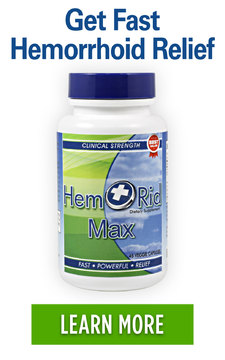Small Hemorrhoids Around Anus – When Small Hemorrhoids Won’t Go Away
Posted on 13 November 2018 by Maryanne Johnson
Share this post
A mild case of hemorrhoids could leave you with relatively small hemorrhoids. You might experience small internal hemorrhoids or small external hemorrhoids. Mild hemorrhoids still give way to annoying and often painful symptoms.
Regardless, small hemorrhoids should be subject to treatment just the same as average-sized hemorrhoids. With smaller hemorrhoids, you have the opportunity to address this anorectal condition before it worsens or you experience certain complications.
You might be tempted to ignore your small hemorrhoids, but keep in mind that if you don’t treat them or determine what your risk factors are, these hemorrhoids could keep coming back. Reoccurring small hemorrhoids can act as a reminder that you may need to change something in your diet or your lifestyle.
There are two types of small hemorrhoids, internal and external. Both types of hemorrhoids have similar symptoms, but many times they produce their own unique set of side effects. The more you know about small hemorrhoids, the better you can be at preventing them from becoming a frequent issue.
Small External Hemorrhoid
External hemorrhoids develop outside of the anus and are presented usually in the form of painful lumps. These lumps can range in size, and while they can be small external hemorrhoids, they all might differ slightly in shape and width.
These small external hemorrhoids are a reaction to venous inflammation in the lower portion of the rectum. You might also feel pain in the anorectal area, swelling, and anal itching. Your bowel movements may cause pain as well as sitting on the toilet.
Small external hemorrhoids still pack quite a punch when they develop, and for people who experience them, everything becomes hindered by their presence. Small hemorrhoids and their painful lumps can impede upon specific exercises and ache and throb, especially in sitting positions.
Avoid engaging in vigorous activities, even with small external hemorrhoids, because friction and chaffing can worsen the inflammation. Treating small external hemorrhoids can force them to shrink more quickly, but even without treatment, they will shrink in a matter of days.
Small Internal Hemorrhoid
Internal hemorrhoids are harder to detect for the obvious reason of their location inside the rectum.
Internal hemorrhoids are tucked away inside the lowest part of the rectum and in mild cases, cannot be seen or felt. Our bodies do not have sensitive pain-feeling nerve endings in this part of the rectum, which is why small internal hemorrhoids go unnoticed most of the time.
Rectal bleeding is a sign of small internal hemorrhoids and happens mainly when a hard stool abrasively scraps against inflamed hemorrhoidal tissue, causing bleeding to occur. The bright red blood is often on the hard-to-pass stool itself, or it can drip from the rectum following a bowel movement. Sometimes, rectal bleeding is from a ruptured internal hemorrhoid.
Factors like constipation and straining aggravate small internal hemorrhoids. The stress and pressure from these factors incite inflammation of the internal rectal veins, resulting in the development of small internal hemorrhoids.
How to Treat Small Hemorrhoids
Treating small hemorrhoids can be easily done in the privacy of your home. Small hemorrhoids usually mean a mild case of hemorrhoids and nothing so severe that they would not respond to at-home remedies.
Treatment and prevention go together in ridding your body of hemorrhoids. When you notice small hemorrhoids developing, act quickly, or small hemorrhoid symptoms can mean that they disappear faster with lessened symptoms.
Here a few basic guidelines to remember when treating your small hemorrhoids:
- Make small changes to your diet by eating more fiber
- Drink plenty of water
- Get outside and exercise, even for a brisk walk
- Avoid sitting on the toilet for too long
- Don’t excessively wipe
- Listen to your body, if you need to see your doctor, do so
Knowing which type of small hemorrhoids you have can also give you an advantage when it comes to treating them. There are different methods you can try for small external hemorrhoids, small thrombosed hemorrhoids, and small prolapsed hemorrhoids.
Small External Hemorrhoid Treatment
Small external hemorrhoids are lumps that originate near the anus. Sitting becomes troublesome and going to the bathroom becomes an uneasy chore.
Try these treatments for your small external hemorrhoids:
- An anti-itch and anti-pain topical cream
- Tucks Wipes with witch hazel
- A hemorrhoid supplement
- A special sitting cushion for hemorrhoids
- A lubricating ointment
- A rectal suppository for hemorrhoids
- A sitz bath
All of these methods treat symptoms of small external hemorrhoids almost immediately. The symptoms of external hemorrhoids last as long as there are anal lumps present in the area. The external hemorrhoid lumps are painful, ache, and can even give off a burning sensation.
External hemorrhoids are much more painful than small internal hemorrhoids because we do have pain-sensing nerves where they develop. External hemorrhoid bumps also manage to get in the way of normal activities and trips to the bathroom.
Using a cushion designed for people with small external hemorrhoids can make sitting more comfortable. Wiping with medicated Tucks Wipes can clean the rectal area and soothe the pain of external hemorrhoids.
Lubricate your small external hemorrhoids with a hemorrhoid cream that is anti-itch and anti-pain, or use a petroleum jelly based ointment to prevent friction from irritating them.
Hemorrhoid suppositories can get to work in stopping the symptoms of small external hemorrhoids in about twenty minutes after they are inserted. For most suppository products, you can use them up to four times per day.
Small Thrombosed Hemorrhoid Treatment
Small external hemorrhoids can become thrombosed, meaning there is a formation of a blood clot trapped within the hemorrhoid. A thrombosed hemorrhoid is even more painful than an external hemorrhoid, sending sensations of sharp shooting pain.
You can use these treatment methods for your small thrombosed hemorrhoids:
- An ice pack to reduce swelling
- A warm bath submerging the hemorrhoid
- Topical creams and ointments that are anti-pain and anti-inflammatory
- Having your doctor lance and drain the thrombosed hemorrhoid
However, if your small external hemorrhoid does become thrombosed, it is highly advisable that you do not try to burst it by yourself. You should make an appointment with your doctor to have the small thrombosed hemorrhoid lanced and drained.
You can monitor your thrombosed hemorrhoid for a day or so because occasionally, they will shrink and go away on their own. It may take a few days for the thrombosed hemorrhoid to disappear, but with these treatments, you can manage the painful symptoms in the meantime.
Small Prolapsed Hemorrhoid Treatment
Internal hemorrhoids can prolapse, extending themselves beyond the rectum. For this reason, internal hemorrhoids are rated on different Grades. If you have a small prolapsed hemorrhoid, then you likely have Grade I hemorrhoids, which are considered to be a mild case.
Trying these treatments can help remedy your small prolapsed hemorrhoid:
- Pushing the hemorrhoid back inside the rectum
- Soaking in a warm bath
- Eating more fiber
- Taking a fiber supplement
- Using a hemorrhoid supplement
- Taking a stool softener or laxative
Do not strain on the toilet when you have a small prolapsed hemorrhoid, or you could worsen your condition. By preventing straining, you can treat your prolapse, and the best thing, to begin with, is by eating more fiber or taking a fiber supplement.
Fiber will make your stools softer, and softer stools mean healthier bowel movements and less straining. A regular colon with bulked, moisture-filled stools can undercut inflammation, making it easier on your rectal veins during a bowel movement.
What Does a Small Hemorrhoid Look Like?
Small hemorrhoids, whether they are internal or external, look like little bumps or protrusions. Small external hemorrhoids are flesh-colored, sometimes more darkly hued than the surrounding skin, and collect near the anus.
Small internal hemorrhoids cannot be seen, but if you experience a prolapse, the hemorrhoid will likely be covered in mucus, blood, and other internal fluids. The prolapsed hemorrhoid can look red, pink, or can be darkly pigmented.
Conclusion
You might notice with small hemorrhoids some swelling, redness, or anal discharge. Small hemorrhoids also can appear blue or purple if they become thrombosed. As you know, external hemorrhoids are the type of hemorrhoids that can become thrombosed, and if this occurs, you will notice their coloring change due to the blood collecting within.




0 comments